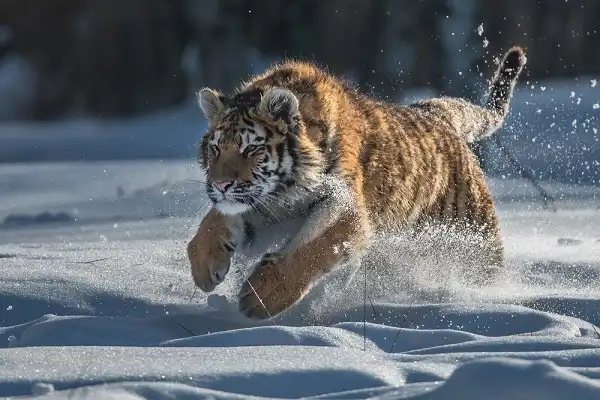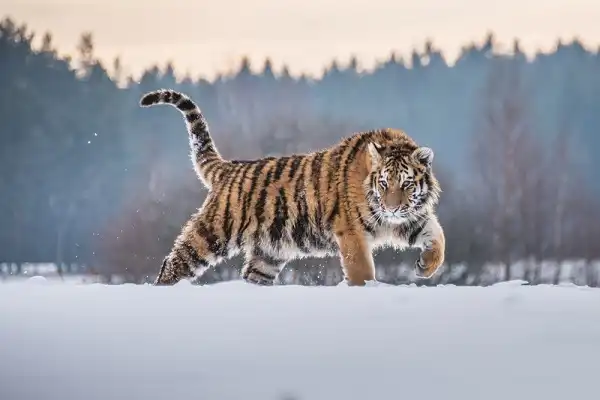From its striking orange and black stripes to its commanding presence in the Siberian taiga, the Siberian tiger is one of nature’s most awe-inspiring creatures. This species of big cat is known for being particularly powerful and elusive, thus making them quite difficult to study in their natural habitat. As a result, much about this majestic animal remains veiled in mystery. However, knowledge obtained through research over the last several decades has increased our understanding of this endangered icon—from its diet and behavior to threats facing its survival today. In this blog post, we will explore some fascinating facts about these mysterious cats and uncover why protecting them must be a priority for us all.

Siberian Tiger Description
The Siberian tiger is the largest of all living cats in terms of body size and has a unique orange-black striped pattern, which has become a symbol of its beauty and power. Its coat is thick and woolly, enabling it to brave the frigid temperatures that it inhabits. It also has sharp claws and powerful jaws that allow it to take down large prey with ease. In terms of behavior, these majestic animals are mostly solitary creatures but have been known to form small family groups during mating season or when raising their young cubs.
Siberian Tiger Habitat
The Siberian Tiger is found in the taiga forest of the Russian Far East, as well as parts of North Korea and China. This habitat consists of dense coniferous forests with a wide variety of shrubs and herbs. The tigers prefer to live in areas where there are plenty of prey animals, such as boar, deer, hares, badgers, and other small mammals. They also require adequate water sources for drinking and bathing. The tigers take advantage of the deep snow cover by ambushing their prey at its edges or even building snow caves to rest in during the colder months. The densely vegetated forests provide ideal cover for stalking their prey without being detected. The trees also provide important shelter from extreme weather conditions and offer obscurity from potential predators.
Siberian Tiger Diet
The Siberian Tiger has a varied diet consisting mainly of boar, deer, hares, badgers, and other small mammals. They will also hunt birds, fish, and even sometimes fruit for sustenance. Their sharp claws and powerful jaws allow them to take down large prey with ease. Because of their nocturnal nature, they utilize their impressive senses of smell and hearing to detect their prey from afar. During the colder months when deep snow covers the taiga forest where they live, the tigers take advantage of this by ambushing their prey at the edges or even building snow caves for shelter. In addition to hunting for food sources, Siberian Tigers have also been known to scavenge carcasses left behind by other predators such as wolves and bears in order to supplement their diet. This species of big cat must consume large amounts of food in order to sustain itself given its size and power; an adult tiger can consume up to 30-40 kilograms (66-88 pounds) of meat in one sitting!

Siberian Tiger Size
The Siberian Tiger is the largest of all living cats in terms of body size, averaging around 2.5 meters (8 feet) in length and up to 300 kilograms (660 pounds) in weight. Its thick coat enables it to brave frigid temperatures and its long tail, up to 80 centimeters (2.6 feet) in length, helps with balance and agility while hunting. The tiger’s powerful jaws and sharp claws enable it to take down large prey with ease. The males tend to be larger than the females, with a larger head, neck, and chest as well as longer fur on their legs, back, and belly than females possess. They also have a more muscular build than their female counterparts. The tigers’ paws are also much bigger than other species of cats; on average they are about 20 centimeters (7 inches) wide! Additionally, their claws can grow up to 5 centimeters (2 inches) long and are retractable like most cats.
Siberian Tiger Lifespan
The Siberian Tiger has a lifespan of around 15-19 years in the wild, although some individuals have been known to live up to 20-25 years in captivity. These majestic predators have adapted to the harsh environment of the taiga forest and can survive extremely cold temperatures of up to -50°C! On average, Siberian Tigers reach their full adult size at 3-4 years old and are sexually mature by 5-6 years old. Female tigers typically give birth to two or three cubs once every 2-3 years. The cubs stay with their mothers until they reach independence at approximately 18 months of age.
Siberian Tiger Behavior
The behavior of Siberian Tigers is fascinating and complex. They are solitary animals, living and hunting alone in their territory, yet they use long vocal calls and scent markings to communicate with each other. This is done in order to avoid conflict over scarce resources in the wild. Siberian Tigers have also been known to eat fish or fruit on occasion when available. The densely vegetated forests provide ideal cover for stalking their prey without being detected; it also provides important shelter from extreme weather conditions plus offers obscurity from potential predators.

Siberian Tiger Speed
The Siberian Tiger is a powerful and agile predator, capable of reaching top speeds of up to 57 kilometers per hour (35 miles per hour). This remarkable speed and power are due to their muscular build, strong legs, large paws, retractable claws, and extremely sharp senses. When hunting, they can sprint short distances for a few seconds in order to catch their prey before it can escape. These cats are also able to leap up to 6 meters (20 feet) when chasing down prey or avoiding danger. They possess incredible agility and balance; often times they will launch themselves off trees or rock formations in order to ambush unsuspecting animals below them. Additionally, their long tail helps with balance while running and pouncing on prey. While the Siberian Tiger primarily relies on its speed for hunting purposes, it also uses this skill as an advantage during confrontations with other predators such as bears or wolves. By outrunning these animals it is able to protect its territory or cubs from potential harm.
Siberian Tiger Reproduction
The reproductive cycle of the Siberian Tiger is remarkable and complex. Female tigers typically give birth to 2 or 3 cubs once every 2-3 years. During pregnancy, the female will seclude herself in a den and the cubs are usually born during the spring season. At birth, each cub typically weighs around 1-2 kilograms (2-4 pounds) and they have light brown fur with darker stripes that help them blend into their environment. The mother tiger will take great care of her young, nursing them for several months before gradually introducing them to solid food like small mammals or fish. As soon as they become independent at approximately 18 months old they will start accompanying their mother on hunting trips and slowly learn how to fend for themselves in the wild.
Siberian Tiger Hunting
Siberian Tigers are powerful and agile predators, relying heavily on their speed to catch their prey. When hunting, they typically use short sprints to catch their prey before it can escape. These cats also have excellent agility and balance, allowing them to leap up to 6 meters (20 feet) off trees or rock formations for ambush purposes. These big cats mainly hunt boar, deer, hares, badgers, and other small mammals in the taiga forest where they live. They use their impressive senses of smell and hearing to detect prey from afar as well as take advantage of the deep snow during colder months by ambushing unsuspecting animals at the edges or even building snow caves for shelter. Additionally, they will scavenge carcasses left behind by other predators such as wolves and bears in order to supplement their diet since an adult tiger can consume up to 30-40 kilograms (66-88 pounds) of meat in one sitting!

Conclusion
The Siberian Tiger is a magnificent and powerful creature, relying on its speed and agility to hunt prey, protect their cubs and survive in the wild. Despite its strength and prowess however, this species has become critically endangered due to illegal poaching and habitat destruction. It is essential that we take immediate action in order to ensure the survival of these majestic cats for future generations to admire them in their natural habitat. By implementing proper conservation efforts such as anti-poaching patrols or creating protected areas for the tigers to inhabit, we can help save this species from extinction!
Frequently Asked Question


